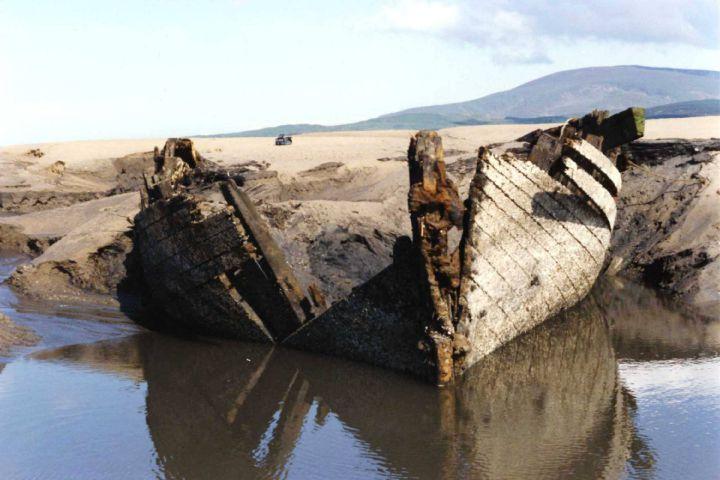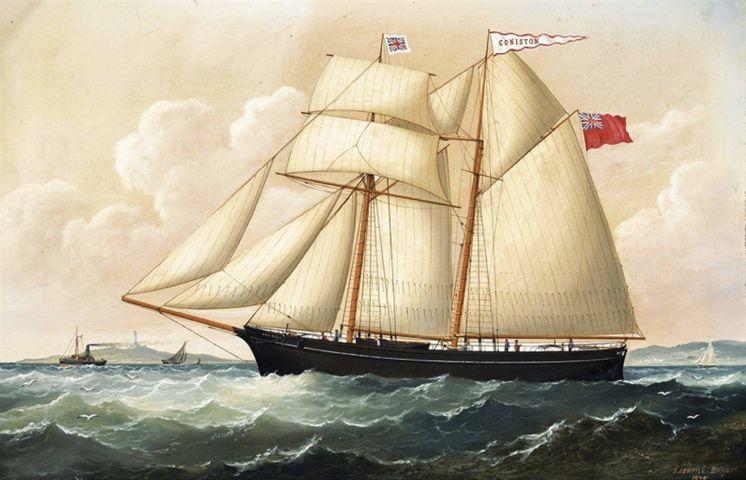THE CONISTON REMOVED. Steam tugs had been engaged upon the work of raising the wrecked schooner each day since Sunday, and on Wednesday afternoon a successful attempt was made, and the Coniston was brought with the tide on to the Duddon sands between Hodbarrow Point and Millom Pier. She showed signs of having encountered heavy gales. On Thursday morning a number of workmen were engaged in making an aperture into the side of the vessel to effect an entrance into the cabin, as it was thought possible the body of the captain's sister might be discovered there. Whilst at work, the men received word that the body of the woman washed ashore on the south end of Walney Island on Monday morning had been identified as that of the young lady who was passenger on the ill-fated Coniston, and the men immediately ceased operations.
WHAT PEOPLE ARE SAYING: That the capsizing of the schooner Coniston off Haverigg on Sunday morning last, with the loss of the crew, caused a profound sensation throughout the District. That the tide was one of the highest experienced at Haverigg for some time. That a sad fact that the captain had his sister on board. That she travelling to Millom with a view to enjoying a holiday in the town. That her body was recovered at Walney and brought to Millom on the train this morning. That their father was also on board, in the capacity of mate. That a young fellow of 18 years of age, Thos. Redmond, is still missing. That his mother resides at Wicklow, Ireland. That this young fellow was a cousin to the captain. That he was on his first sea trip. That sincere sympathy is expressed to the bereaved relatives in their heavy affliction. That Mrs. Dunne, widow of the mate and mother of the youthful captain and his sister, arrived in Millom on Wednesday. That she was accompanied by her daughter and brother-in-law. That the interment of the victims takes place this afternoon. That the Coniston is the third Hodbarrow vessel that has been lost since the outbreak of the war. That the schooner was built at Ulverston 40 years ago.
THE INQUESTS. Mr. W. T. Lawrence, Coroner, held an inquest at the Harbour
Hotel on Wednesday morning upon the three bodies of the crew, which had been
washed ashore and removed to the hotel. Mr. Fox was foreman of the jury.
Mr. S. Wilson represented the owners of the schooner, the Hodbarrow Mining Company, and
Inspector Huck was also present.
IDENTIFICATION OF THE BODIES. Captain Edmundson, master of the tugboat at
Hodbarrow, was the first witness called. He said he knew the three members of
the crew - William Dunne, Joseph Dunne, and Joseph O'Toole, and he identified
the bodies the jury had just viewed as those of the three men. He was well
acquainted with them, and identified them by their features, which were
quite recognisable. William Dunne was the master of the
schooner Coniston, which was one of the Hodbarrow fleet of boats.
He was 20 years of age. Joseph Dunne was the mate, and was 70 odd years
of age, whilst Joseph O'Toole was an able seaman of the same boat.
Witness
last saw them alive on the 25th June at the Bar Buoy in the Duddon Estuary,
and was then parting company with them after taking them out with the tug.
They had not been to the Duddon since. Witness was expecting them to arrive at
the Duddon, but not that morning. When he parted from them on June 25th they
were going to Ayr, from whence they intended to go to Bray, in Ireland. He was
expecting them from Bray, but they called at Ramsey, Isle of Man, on account
of the bad weather, and came on from there bound for Millom. Witness did not
see the schooner on Sunday morning, but saw the wreck afterwards.
The
Coniston was a good few years old, and was well founded in every respect, and,
in his opinion, was capable of withstanding any ordinary storm. On Sunday a
strong breeze was blowing from the west right up the Duddon, and the sea was
very rough. Witness did not know that the Coniston was in the Estuary until he
visited the wreck later on. Often there had been more sea than on this
occasion and boats had come through alright. The Coniston was laden with
timber, and had a deck cargo.
The Coroner:
How is it that the Coniston is in charge of such a young sailor?
Witness; I cannot say.
How long has he been master?
Nearly two years.
Joseph Dunne was his father?
Yes, sir.
Had he ever been master?
I cannot say; has been at sea all his life.
Was Wm. Dunne an able young fellow?
Yes.
Was he a good seaman?
Yes, so far as I know, he was.
Joseph Dunne, the father, was also a man of experience
Yes, he had had great experience, had the old man.
What do you say about the able seaman, O'Toole?
I don't know much about him.
How many in the crew had the Coniston?
Three when she left here on the 25th June. The deceased men were the crew.
Mr. Wilson
said the captain was a master before he was put in charge of the Coniston, and
was master of a much larger boat previously. He had every confidence in the
young fellow, or he would not have put him in charge of the boat.
THE VERDICT. The Foreman said the jury were unanimous in their verdict of Found Drowned. He wished to express, on behalf of the jury and himself, sympathy with the relatives.
RELATIVES IDENTIFY BODIES. Mrs. Dunne, mother of the deceased captain,
accompanied by her daughter and another relative, arrived in Millom from
Ireland on Wednesday afternoon. They proceeded to Haverigg, and Mrs. Dunn
identified the bodies which
had been washed ashore as those of her husband, son, and a relative. On
Thursday she identified the body left by the tide on Walney Island on Monday
as that of her daughter, Kathleen Dunne, 22 years of age, who was a passenger
on board the Coniston, and was intending to have a short holiday in Millom.
A BODY STILL MISSING. There is still another body missing, that of youth
named Thomas Redmond, aged 18, of Wicklow, cousin of
the late Miss Dunne.
Persons lost (all from Wicklow, Summerhill district):
crew: Captain William Dunne (22); Mate Joseph Dunne(70); seaman
Joseph O'Toole(30);
passengers: Kathleen Dunne (22) and Thomas Redmond (18).
Postscript In 1987, the remains of a wooden vessel reappeared from
the sands between Hodbarrow and Millom. This was considered to be the Coniston
that had been abandoned there in 1917. It is now (2019) not visible.

Coniston was built by White of Ulverston and launched on January 17 1874,
sideways into the ship canal. She was owned by William Postlethwaite of
Silecroft (Hodbarrow Mining Co) and her first captain was William Fairclough.
He owned a painting by Joseph Semple of her off Anglesey en route to Liverpool.

At launch, she was described as strongly built (so that she could take the ground at Millom) and with length of keel 78 ft; breadth of beam 20 ft; depth of hold 9 ft; register tonnage, about 90 tons, and she is expected to carry 180 tons.
One theory proposed for the loss was that the vessel arrived one hour earlier than high water, because of confusion over British Summer Time (first introduced in 1916) and the tide tables in GMT.